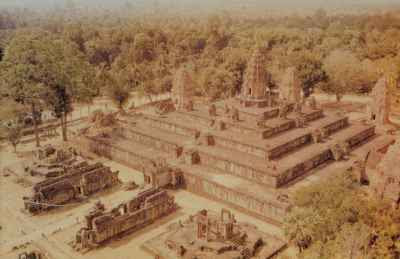The Guardians of Hariharaalaya

One goes to Siem Reap only to see Angkor Wat. But only after landing there does one start discovering the other treasures scattered all over the old Khmer kingdom. The travel planners dole out these treasures according to the time you have. The amazing Angkor Wat and the bewitching Bayon are fixed items and others are a-la-carte.
I was overwhelmed by the lists. Reading up about each one made me rue the fact that we had apportioned only three and a half days for Siem Reap. It was like the proverbial kid- in- candy- store ; in my case, an archeology-nut me in a countryful of ruins.

I had to give up Phnom Bakheng , the cradle of the Devaraja cult, the birthplace of the First Angkor Empire, with the huge presiding Lingam , Yashodhareswara, (established by Yasovarman I in 889 AD.) still standing, open to the sky, atop the hill. It rained on the evening of my plans for it. So, abandoned.

But, as a compensation, i managed to visit Bakong in the old capital Hariharaalaya, now part of what is called The Rulous Group. And was thrilled to learn that this capital, established by Indravarman I in 881 AD was the original model on which Phnom Bakheng was built. This " stone house of Isa" ( as named in an inscription) is one of the very first Temple-Mountains built in South East Asia.
Modelled after the mythical Meru surrounded by moats representing the oceans. Five stepped terraces stacked in pyramidal form reaching for the sky. The moats and the sacred pond Indrathataka have dried up. All stauary including the presiding lingam Indreswara and the life sized , headless, monilithic sculpted trio "Umagangapateeswara" have been removed to the safety of museum warehouses. Only some broken nosed elephants and lions stand. But the climb is well worth the effort. The view from atop is breathtaking.
Lolei and Preah Ko of theThe Rulous group have more carvings representing the art of Hariharalaya. The Dwarapalas and Dwarapalikas are wonderful.

In fact, i noticed that while the sculpture of the main Devas ( siwa, visnou, buddha) , seen in the museum, have very minimalistic adornment, the attending personnel are more embellished. The door guardians of Lolei and Preah Ko, left in situ, are a bewitching lot. Each with his own facial features and expression. Nothing assembly-line about them. The Apsaras , though, have a generic look. Only their hairstyles are different.

After the mela -like crowds of invading tourists at Angkor Wat ( of Suryavarman fame), Bayon(of Jayavarman fame) and Ta Prom ( of Angelina Jolie fame) , Hariharaalaya is like a sanctuary of peace and serenity.
Loved the fact that there there were just 4 people around when we visited.
 ________________________________________________________
________________________________________________________BAYON
When a place becomes too well known, widely famed as One Of The Wonders of The World, is much written about and vigourously sold by all Tourist Agencies as a "Must See " destination , it evokes anticipation of enormous proportions. ANGKOR WAT is stuff of legends. When one finally stands there looking up at the spires, does it deliver ? Just one word : YES ! And how !
Angkor Thom or The Old City of Angkor is a real marvel. Enthralling. Since Angkor is the magnet that attracts the much needed Tourist money to the impoverished country, the Government has sensibly taken good care to have an efficient Tourism Department. A three day Pass with the tourist's photo on it is a good measure because all important monuments being situated within the old walled city, now the Protected Archeological Area, it can take anywhere between three to five days to have a really good look at all the treasures there.
As soon as one enters the Thom, the first group of sculptures one can see are rows of Asuras and Devas in the act of "Churning The Ocean" Samudra Manthan " . This is the prevalent motif, found everywhere. Since the Angkors believed in the Divinity of Kings, this motif from the Creation myth is very apt for creation of the dynastic capitals.
Bayon is the first stop. The gateway is crowned by a gigantic head of a smiling king. This is the unique pagoda design found on all the spires of the the Bayon shrines. There are about 54 such faces, facing all directions. The wall panels illustrating daily life under the king, the wars and scenes of the Hindu epics are intricate and dramatic. And there are all those Apsaras as decoration on pillars and pilasters.
Since the place is still being renovated, large parts of it still in a rubble, climbing up and down the terraces can be a bit tricky. But the view from the top, with a close up of the King's face, is well worth the trouble.



Comments